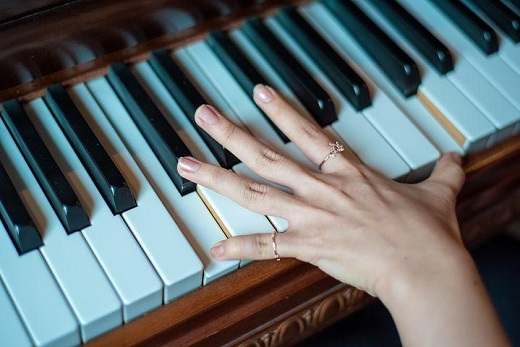
A piece frequently heard at concerts, Grand Valse Brillante by Chopin is, as its title suggests, a dazzling and impressive composition.
This piece is one of the waltzes composed by Chopin. There are a total of 19 waltzes. Among them, Nos. 1 through 14 are famous and challenging, while Nos. 15 through 19 are comparatively easier.
In Chopin’s extensive body of work, the waltzes are considered relatively approachable. Many people, including myself, start studying Chopin with his waltzes.
This time, I’ll share tips to help you play Grand Valse Brillante with brilliance and agility. These tips aren’t just for this piece—they’ll also be useful for other waltzes by Chopin. Please give them a try!
Contents
How Difficult Is “Grand Valse Brillante”?
This piece is numbered as No. 1 in Chopin’s waltz collection. If you’re thinking of practicing Chopin’s waltzes and pick up a score, please don’t start with No. 1 just because it’s the first.Why? Because, in my opinion, this is the most difficult piece in the collection.
Some people, particularly those with larger hands or male pianists, may find it easier to play. However, since my hands aren’t particularly large, I struggled a lot with this piece.
Moreover, the tempo is fast.
For those who are just starting with Chopin’s waltzes, I’d recommend starting with No. 3, No. 6 (“Minute Waltz”), or No. 9 (“Farewell Waltz”).
As for me, I started with “Farewell Waltz”. Its stunningly beautiful melody captivated me, and this piece made me fall in love with Chopin’s music.
First, Learn the Flow of the Piece
This piece is one of the longer works in Chopin’s waltz collection. It almost feels like a medley as the music flows and develops continuously.
Start by carefully and slowly reading the score.
You’ll notice some phrases repeat multiple times, but with subtle differences. For instance, a chord might be missing the third or fifth note. These small variations can be confusing, so if you can memorize the piece while practicing, it will save you effort later.
As mentioned earlier, the tempo is fast, so memorization is essential.
For sections where the melody is in double notes, try isolating the melody for practice. This will help you balance the volume and bring out the melody more effectively. Listen closely to your sound to create a sense of depth.
For the ornamented notes in the middle section, start by playing them without the ornaments and then add them in later. This is because these ornamented notes are easier to play when aligned closely with the melody. Think of them as slightly staggered double notes, and you’ll be able to maintain a smoother tempo.
The Left-Hand Accompaniment Defines the Mood of the Piece!

The reason a waltz often feels heavy usually lies in the accompaniment. And the cause of this is often a stiff wrist or an inability to perform proper up-and-down wrist movement.
In Chopin’s works, it is impossible to produce his characteristic delicate sound without using flexible wrist and elbow movements. Conversely, in works from periods earlier than the Romantic era, such techniques are often not preferred.
The golden rule for waltzes is to play the first beat, the bass note, heavily and weightily, while the second and third beats are light or soft. The key is how you use your wrist for the second and third beats.
Think of it as “lowering your wrist slightly before playing the chord, and as you raise it, the fingers lightly touch the keys, creating the sound almost unintentionally.” This light touch should still firmly capture the chord.
The flexible up-and-down wrist movement is crucial.
Chopin and Liszt often demand this motion in their works. By letting go of the idea of “playing,” you can achieve a light and lively accompaniment.
In fact, even when you want to produce a louder sound, this wrist motion is essential.
 For example, in the first beat of measure 8, you can produce a soft yet solid volume by using your wrist. Relying only on finger strength creates a harsh sound, so be sure to listen closely to your sound and refine your wrist technique.
For example, in the first beat of measure 8, you can produce a soft yet solid volume by using your wrist. Relying only on finger strength creates a harsh sound, so be sure to listen closely to your sound and refine your wrist technique. It is essential to perform wrist movements naturally.
Finishing the Piece!

The tempo marking “vivo” in this piece means “lively, vivacious.”
Thus, an appropriate tempo is necessary. For challenging sections, such as repeated notes, take them out and practice them thoroughly.
If you struggle with repeated notes, incorporating exercises like No. 22 from Czerny’s The School of Velocity, Op. 299, or No. 44 from Hanon might be beneficial.
Additionally, adding “rubato” or tempo fluctuations like pauses and accelerations can create a performance that feels emotionally rich.
However, overdoing this can result in a persistently unnatural performance, so proceed carefully! Always record your performances to evaluate them.
Even if you feel great while playing, you might discover areas later where you think, “This wasn’t necessary.”
These elements are not written in the score, which makes them challenging. They also require a sense of musicality. Try incorporating them in places where you want to draw attention to the music.
Listening to a lot of performances might be the fastest way to develop this.
Summary
① Take your time with memorization while carefully and accurately reading the score.② Use flexible wrist and elbow movements to create light and elegant accompaniment.
③ Add expressive tempo fluctuations to create a richly emotional performance.
④ Always record your performances and check them.
As I’ve mentioned before, flexible hand movements are incredibly important in Chopin’s pieces.
Even difficult sections can often be resolved, and the strain on your hands reduced, by mastering this technique.
Waltzes are often studied early on in Chopin’s repertoire. So, before tackling the more challenging works later on, be sure to acquire this technique here.
- IMSLP (Sheet Music Link)
This article was created using this sheet music. It is a public domain edition published by Durand in 1915.
- How to Master Chopin’s “Grand Valse Brillante”: Difficulty Level and Essential Waltz Techniques 2017/6/2 ←Currently Viewing Article
- Play with Fingerings That Suit You! Chopin’s “Grand Valse Brillante” Difficulty and Tips for Playing 2017/6/29
- 華やかなワルツの世界!ショパン「華麗なる大円舞曲」弾き方と難易度 2017年12月6日
- Ranking Chopin’s Waltzes by Difficulty: A Piano Teacher’s Perspective 2017/3/17
- Perfect for a Piano Recital! Chopin's “Minute Waltz”: Difficulty and 3 Tips for Playing It 2017/5/25
- How to Master Chopin’s “Grand Valse Brillante”: Difficulty Level and Essential Waltz Techniques 2017/6/2 ←Currently Viewing Article
- Play with Fingerings That Suit You! Chopin’s “Grand Valse Brillante” Difficulty and Tips for Playing 2017/6/29
- How to Master Chopin's “Minute Waltz”: 8 Essential Tips and Difficulty Insights from a Mole 2017/7/6
- これで挫折知らず!ショパン『ワルツ第7番op64-2』弾き方のコツと難易度 2017年7月14日
- 華やか&叙情的!ショパン『ワルツ第14番ホ短調遺作』弾き方のコツと難易度 2017年8月6日
- ロマンティックな恋!ショパン『ワルツ第9番op.69-1』の弾き方と難易度(『別れのワルツ』『告別』) 2017年11月8日
- 華やかなワルツの世界!ショパン「華麗なる大円舞曲」弾き方と難易度 2017年12月6日
- 初めてショパンを弾く人へ!『ワルツ第10番op.69-2』の弾き方と難易度 2017年12月16日
- 子犬のワルツ。ショパンの名曲のかんたんな弾き方、難易度も解説。(ワルツ第6番変ニ長調Op.64-1) 2018年3月9日
- おすすめしたい隠れた名曲!ショパン:ワルツ第15番ホ長調遺作の弾き方と難易度 2018年3月19日
- 一音入魂!ショパン:ワルツ第3番(華麗なる円舞曲)の難易度と弾き方(Op.34-2イ短調) 2018年5月19日
- ショパン作曲『子犬のワルツ』の難易度は?弾き方を極める7つのコツ 2019年8月1日
















